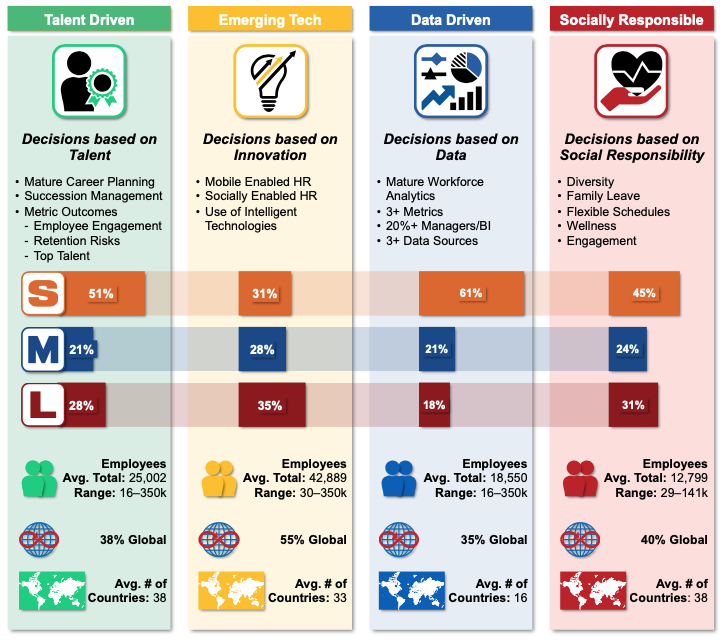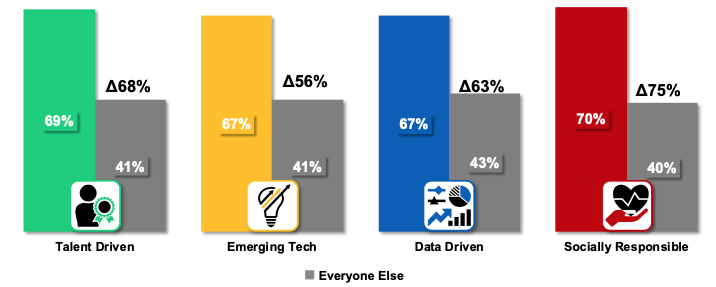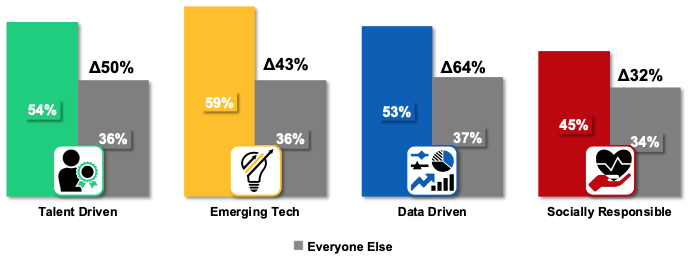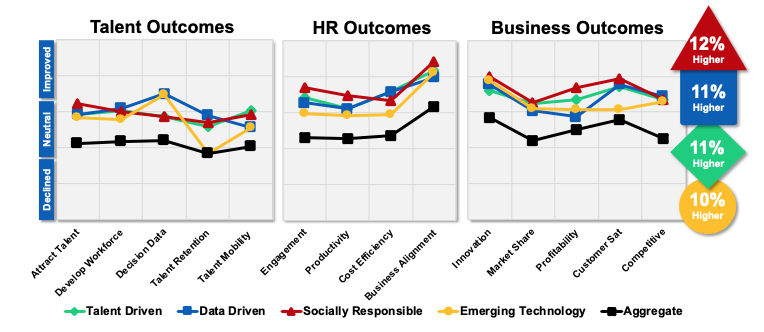Even under normal circumstances, we're all looking for ways to improve our outcomes in business. In uncertain times, it is even more important to find ways to use what you have available to find (and deliver) opportunities to improve business outcomes. In a recent blog, we shared the highlights of the Sierra-Cedar HR Systems Survey Report for 2020. In this week's HR blog, we're going to unpack it a little further. Their detailed research offers some essential insight into the factors that enable the top-performing businesses to continuously improve talent, HR and business outcomes by 15%. Every. Single. Year. The best thing about this blog is - there are lots of pictures (aka charts). And if a picture is worth a thousand words, these ones tell a pretty compelling story about what HR Professionals everywhere can do to win the golden ticket of being perceived by leadership as a 'strategic business partner.'
Sierra-Cedar have developed a pretty sophisticated process for understanding the value that organisations get from HR Software. They've refined it over more than 20 years and their methodology offers some really insightful intel about how to improve focus, outcomes and impact by up to 15% per year. Outlined below are the HR best practice that the report indicates HR Professionals would be wise to spend their time on (and how Sierra-Cedar figured it all out).
The Top 4 Factors That Contribute to Improved Talent, HR and Business Outcomes
Each year, Sierra-Cedar look at over 250 different data points from the responding organisations and statistically determine which factors correlate to higher or lower Talent, HR, and Business outcomes. In any given year, these factors change slightly depending on the economy, industry trends, or respondent demographics. What they tend to look for in these types of analyses are the things that show up year after year, the factors that provide the highest level of confidence in the findings.
During each of the last five years of their detailed process of analysis, they have found four consistent factors that correlate to higher business outcomes. Conversely (and perhaps even more importantly), what the survey results also consistently indicate is that the lack of these factors correlates to lower-than-average business outcomes. In this year alone, their analysis revealed improved business outcomes based on the presence of the following four factors:
-
Regularly updated HR systems strategy (10% better outcomes).
-
Regularly updated integration strategy (12% better outcomes).
-
Perception of HR, viewed as adding strategic value to multiple levels of management (23% better outcomes).
-
Culture of change management (28% better outcomes).
The long and the short of it is this: if Boards, Leaders, Managers and HR Professionals had been focusing on these four factors (and actually had them in place during the last five years), your organisation would have been likely to have generated an average 15% increase in your combined Talent, HR, and Business outcomes during each of those 5 years.
That's an average fifteen percent increase year on year.If that isn't an emphatic endorsement for HR Professionals and business leaders everywhere to drop everything else and focus in on those four factors, I don't know what is. Easier said than done, even under 'normal' circumstances, let alone the ones we're facing currently. However, an average 15% increase is not an insignificant number for a year on year increase in outcomes, so it is worth a pause to pay attention and reconsider your current strategies.
Four Types of Outcome Focused Organisations
As part of their annual survey, Sierra-Cedar asks organisations to indicate whether a series of Talent, HR, and Business outcomes have declined or improved over the last 12 months. In addition to these outcome questions, they then take the time to independently gather financial metrics for all the publicly traded businesses that take the survey. They then compare multiple organisational aspects across both the outcomes matrix and the financial data as a way to compare different organisational behaviours and types.
As their research has expanded, they've also widened the survey's scope beyond financial metrics to include specific criteria relating to organisational behaviours that provide insight into cultural priorities and decision-making processes. As a result, they've identified four types of 'Outcome Focused' organisations.
Each of these outcome focused organisation types creates its own level of innovation; from processes, to people, to technology adoption strategies. This supports the view that there are multiple ways to generate business outcomes while staying true to your organisation’s unique culture and capabilities. The figure below illustrates demographic data for the four outcome focused organisational types.

HR Focus, Outcomes & Impact Trends
Sierra-Cedar also take the time to identify all the participants who answered the determining questions for each category but did not meet the qualifications to be one of the four outcome focused organisational types and their answers are included in the charts below as a comparison group.
Once organisations are categorised appropriately, they are able to use the data generated by the report to compare multiple variables:
-
Financial and business value outcomes.
-
Key practices (process, technology, and people).
-
Talent, HR, and business outcomes.
Additionally, Sierra-Cedar assess various financial metrics that include:
-
Revenue per employee.
-
Profit per employee.
-
Operating income growth.
-
Return on equity.
They look at results for publicly traded organisations, but remind us that profits and shareholder value should not be the only goal of an organisation. In August 2019, the Business Roundtable issued a statement on the purpose of a corporation, arguing that, 'companies should no longer advance only the interests of shareholders. Instead, they must also invest in their employees, protect the environment and deal fairly and ethically with their suppliers.' Financial stability is a critical metric for any organisation, but along those same lines they assess other metrics such as perception factors, talent outcomes, HR outcomes, and ultimately long-term business outcomes.
The Strategic Perception of HR via Outcome Focused Organisations Strategic Value
Sierra-Cedar then analyse business leaders’ perception of the strategic value of their HR function. They assess whether HR is viewed as a compliance-based function or as strategic business partner that adds value to business outcomes within the organisation. The comparison analysis for this question across the four outcome focused organisations shows a considerably higher percentage when HR is viewed as a strategic business partner. Why is this so important? The respect and perceived value of HR plays a major role in the ability to help an organisation achieve its organisational goals.

The second analysis they conduct is a review of how businesses are using their HR technology environments to inform their business strategies. Once again, all four outcome focused organisations are much more likely to use their HR Software to help Inform business strategy (as opposed to just using it to replace paper processes or manage compliance issues). Despite the fact that HR systems enable you to leverage data and insights about your business to inform business strategy, actually achieving this promise requires focus and prioritisation of critical internal behaviours (from both HR and the wider business).

Essentially, what that boils down to is that outcome focused organisations have significantly higher outcomes in comparison to the aggregate data set year on year.
-
Socially responsible organisations achieved the best outcomes overall at 12%.
-
Both data driven and talent driven organisations were at 11%.
-
Emerging technology achieved 10% higher outcomes.
As we've shared with you previously on the HR Blog, the rise of the social enterprise is no mere fad, and these figures reinforce that fact. Ultimately, Sierra-Cedar's survey results provide insights on the type of organisations you may look to benchmark against over time.

Is your business using #HRtech to inform your business strategies? If not, then you need the right tools to make it possible to find efficiencies in times of change so that you can enable your organisation to improve your talent, HR and business outcomes by 15% in the next year. How would it feel to achieve that in your business?
Take a look at the new workforce shaping functionality we've just released. Our remuneration modelling tool makes it easy for you to model multiple REM scenarios so that you can find the one that best suits you today. And if that changes in the future, simply build and test some new models and implement any changes seamlessly.
To find out more about the latest #HRtech we've released, simply click on the button below to explore the remuneration modelling tool.


